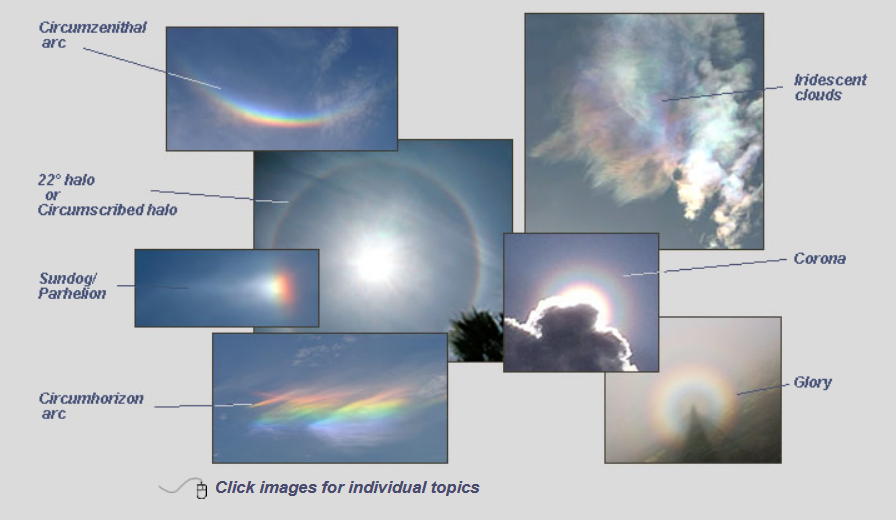Colored Arcs Not Rainbows
Colored Arcs: Not Just Rainbows
When we look up at the sky, we are often treated to a variety of breathtaking sights. One of the most captivating phenomena is the appearance of colored arcs. While many may mistake these arcs for rainbows, they are actually distinct optical phenomena that occur under different conditions. In this article, we will explore the fascinating world of colored arcs and delve into their formation and characteristics.
Rainbows, as most of us know, are formed by the refraction and reflection of sunlight by raindrops. However, colored arcs are formed through a different set of mechanisms. These arcs primarily arise when sunlight interacts with ice crystals or small cloud and fog droplets. Let's take a closer look at the different types of colored arcs and how they come to be:
Halo: A Ring of Light
Halo is a term used to describe a ring of light that surrounds the Sun or Moon. This awe-inspiring phenomenon is caused by the refraction and reflection of sunlight by ice crystals present in high-altitude cirrus clouds. As sunlight passes through these hexagonal ice crystals, it undergoes multiple internal reflections and refractions, resulting in the formation of a circular halo around the celestial body.
Glory: A Magnificent Optical Illusion
A glory is another captivating optical phenomenon that can be observed under specific atmospheric conditions. It appears as a series of concentric colored rings centered on the shadow of an object, such as an aircraft or a mountain peak, when viewed from above the clouds. Glories are formed by the diffraction of sunlight by small water droplets or tiny ice crystals in clouds or fog.
Coronae: A Delicate Circular Array
Coronae are circular arrays of colored rings that encircle the Sun or Moon. Unlike halos and glories, coronae are formed through diffraction rather than refraction or reflection. When sunlight encounters tiny water droplets or ice crystals in the atmosphere, it undergoes diffraction, resulting in the creation of these delicate, multicolored rings.
Iridescent Clouds: A Play of Colors
Have you ever witnessed clouds shimmering with a mesmerizing display of iridescent colors? These captivating phenomena are known as iridescent clouds. They occur when sunlight is diffracted by small water droplets or ice crystals within the cloud. The diffracted light creates a beautiful array of colors, resembling the hues seen in soap bubbles or oil slicks.
Additional Factors: Atmospheric Optics at Play
While the mechanisms described above are responsible for the formation of colored arcs, there are several additional factors that contribute to the intricate interplay of light and atmospheric optics:
- The size and shape of ice crystals or droplets play a crucial role in determining the appearance and characteristics of colored arcs. Different shapes and sizes result in variations in the intensity and distribution of colors.
- The angle at which sunlight interacts with the ice crystals or droplets affects the size and position of the colored arcs. This angle can change depending on the observer's location and the position of the Sun or Moon.
- The presence of other atmospheric phenomena, such as rain, fog, or pollution, can influence the visibility and clarity of colored arcs. These additional elements can scatter or absorb light, altering the appearance of the phenomena.
In conclusion, while rainbows are undeniably captivating, they are not the only colored patches that grace our skies. Colored arcs, such as halos, glories, coronae, and iridescent clouds, offer us a glimpse into the intricate world of atmospheric optics. Understanding the mechanisms behind these phenomena allows us to appreciate the beauty and diversity of nature's kaleidoscope above us. So, next time you spot a colored arc in the sky, take a moment to marvel at its unique splendor and remember that it is not just a rainbow.
Not all coloured patches in the sky are rainbows.
Rainbows are formed by refraction and reflection of sunlight by raindrops. When sunlight passes through ice crystals, halos form and they are mostly coloured . Small cloud or fog droplets diffract light to form ringed glories, coronae and the jumbled colours of iridescent clouds.

Note: this article has been automatically converted from the old site and may not appear as intended. You can find the original article here.
Reference Atmospheric Optics
If you use any of the definitions, information, or data presented on Atmospheric Optics, please copy the link or reference below to properly credit us as the reference source. Thank you!
-
<a href="https://atoptics.co.uk/blog/colored-arcs-not-rainbows/">Colored Arcs Not Rainbows</a>
-
"Colored Arcs Not Rainbows". Atmospheric Optics. Accessed on April 27, 2024. https://atoptics.co.uk/blog/colored-arcs-not-rainbows/.
-
"Colored Arcs Not Rainbows". Atmospheric Optics, https://atoptics.co.uk/blog/colored-arcs-not-rainbows/. Accessed 27 April, 2024
-
Colored Arcs Not Rainbows. Atmospheric Optics. Retrieved from https://atoptics.co.uk/blog/colored-arcs-not-rainbows/.